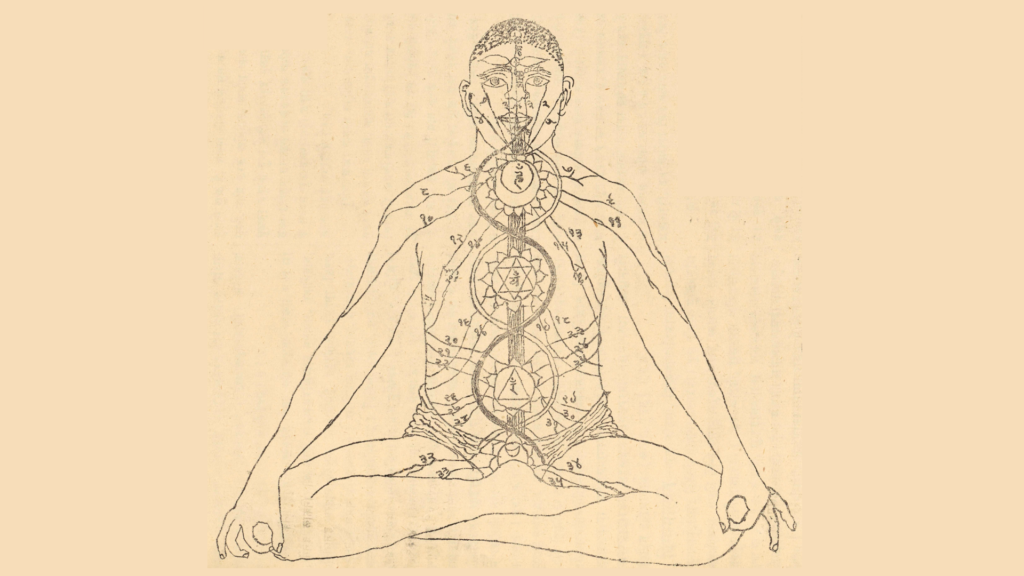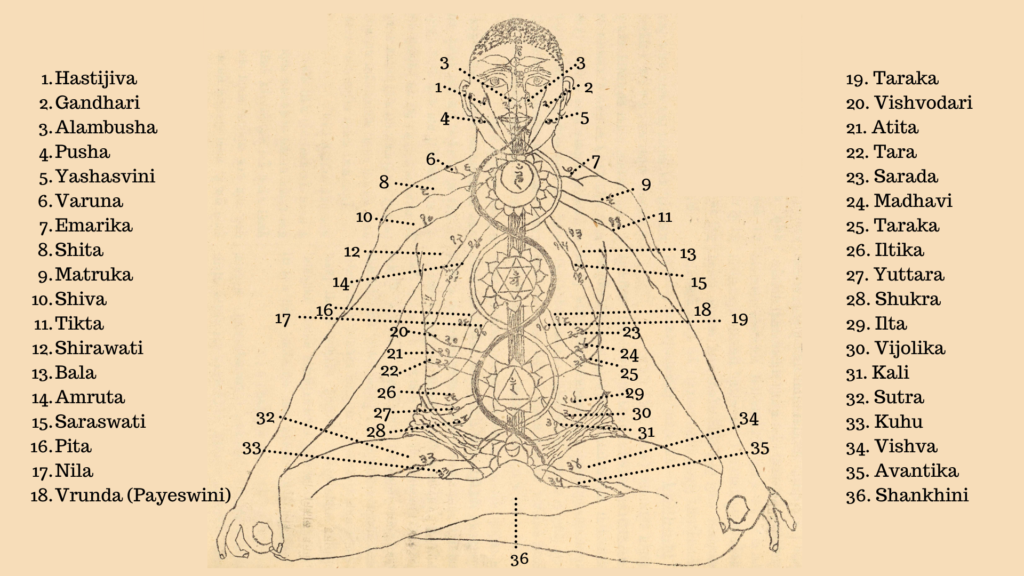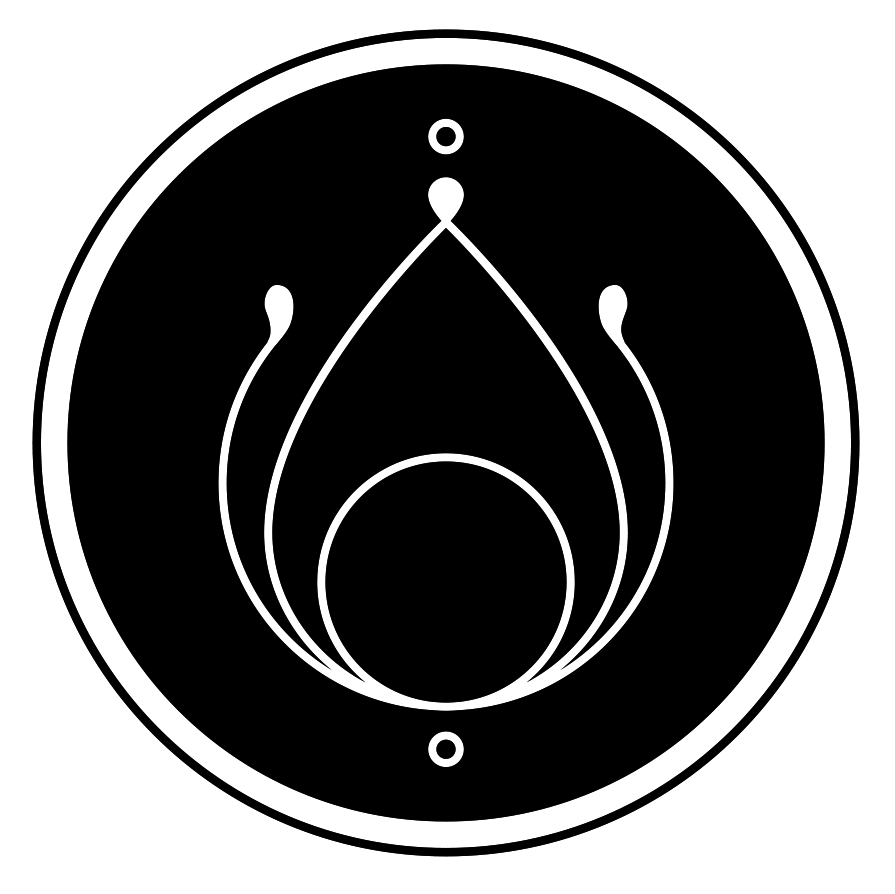Nāḍīs & Marmas

Συνήθως, ο όρος Nāḍīs χρησιμοποιείται για τα πράνα Nāḍīs, δηλαδή λεπτοί ενεργειακοί αγωγοί λεπτών, αιθερικών ή Prāṇā ενεργειών ή “ανέμων”. Συνδέουν το φυσικό σώμα (το δοχείο τροφής και το δοχείο Prāṇā) με το λεπτό σώμα (Manas, Buddhi and Karana Sarira) ώστε το φυσικό σώμα να υπάρχει και να λειτουργεί.
Κάθε ένα από τα 144 τσάκρα δίνει γένεση σε έναν συγκεκριμένο αριθμό Nāḍī, καθένα με μια ειδική λειτουργία. Όμως, η προέλευση όλων των Nāḍīs βρίσκεται στο Chakra Nāḍīs, πιο κοινά γνωστό ως Kaṇḍa ή Kuṇḍalinī Chakra. Το Kaṇḍa είναι ακριβώς πάνω από το Mūlabandha Chakra. Βρίσκεται στην ένωση όπου το Suṣumnā Nāḍī συνδέεται με το Mūlabandha Chakra και από το Kaṇḍa χιλιάδεςNāḍīs αφήνουν να δημιουργήσουν ένα δίκτυο σε όλο το σώμα και ακόμα πέρα από το σώμα. Το Kaṇḍa έχει σχήμα αυγού και είναι λευκό.
Από όλα αυτά τα Nāḍīs (από 72,000 έως 350,000 ανάλογα με την πηγή) μόνο 14 θεωρούνται σημαντικά. Αλλά για το γιόγκι μόνο 3 από αυτά είναι σημαντικά:
- Suṣumnā
- Iḍā
- Piṅgalā
Στη διπλή τους όψη, η Iḍā και η Piṅgalā Nāḍī αντιπροσωπεύουν την ημέρα και τη νύχτα, το χώρο και το χρόνο. Αυτά τα Nāḍīs, σπειροειδώς ανεβαίνουν τη σπονδυλική στήλη. Συνδέονται με την 6 chakra, όπου δημιουργούν με τη Suṣumnā, τον Τρισύνδεσμο της Απελευθέρωσης, όπου εισέρχονται στη Suṣumnā και στη συνέχεια χωρίζονται και προχωρούν στα διάφορα ρουθούνια.
Nāḍīs & Εγκέφαλος
Iḍā & Piṅgalā ΣΤΑ ΤΡΙΑ ΚΥΡΙΑ ΕΠΙΠΕΔΑ ΤΟΥ ΝΕΥΡΙΚΟΥ ΣΥΣΤΗΜΑΤΟΣ:
- Αισθητικοκινητικό νευρικό σύστημα (SMS): Όλη η ηλεκτρική δραστηριότητα στο σώμα κινείται προς μία από δύο κατευθύνσεις, προς τον εγκέφαλο (κεντρομόλο), Iḍā, και από τον εγκέφαλο (φυγόκεντρο), Piṅgalā. Οι γιόγκι αποκαλούσαν τα αισθητήρια νεύρα που ελέγχονται από την Iḍā, γνιάνεντριγιας, και τα κινητικά νεύρα, που ελέγχονται από την Piṅgalā, καρμεντριγιας. Αυτά τα νεύρα ασχολούνται με την αντίληψη και τη δραστηριότητα στον κόσμο.
- Αυτόνομο νευρικό σύστημα (ANS): Το αυτόνομο νευρικό σύστημα χωρίζεται στο εξωτερικά κατευθυνόμενο, αντιμετώπιση του άγχους, χρήση ενέργειας, Piṅgalā κυρίαρχο, συμπαθητικό νευρικό σύστημα, ή στο εσωτερικά κατευθυνόμενο, διαχείριση της ξεκούρασης, εξοικονόμηση ενέργειας, Iḍā κυρίαρχο, παρασυμπαθητικό νευρικό σύστημα. Αυτά τα δύο συστήματα ελέγχουν και ρυθμίζουν όλες τις αυτόματες διαδικασίες του σώματος: καρδιά, πίεση αίματος, αναπνοή, πέψη, συκώτι και νεφρά κ.λπ.
- Κεντρικό νευρικό σύστημα (CNS): Αποτελείται από τον εγκέφαλο και τον νωτιαίο μυελό και περιέχει τους ελέγχους για το SMS και το ANS. Ο εγκέφαλος περιέχει πολύ περισσότερα από αυτό, αφού είναι ένας τεράστιος, εξαιρετικά περίπλοκος υπολογιστής, που αποθηκεύει και ενσωματώνει πληροφορίες και θέτει τις αποφάσεις μας σε δράση με μια εξαιρετικά συγχρονισμένη και ενορχηστρωμένη απόδοση. Η λειτουργία του είναι σίγουρα πολύ περισσότερο από το άθροισμα των μερών του. Μέσα στην απεριόριστη κυκλωματική του εγκεφάλου κατοικεί περισσότερο δυναμικό από ό,τι μπορούμε να συνειδητοποιήσουμε σε μια ζωή, ωστόσο, οι τεχνικές της γιόγκα συστηματικά καθαρίζουν και ενδυναμώνουν αυτά τα κυκλώματα με τακτική πρακτική.
Αυτό είναι που οι γιόγκι μας λένε, ότι το κυκλωματικό σύστημα των Nāḍīs και τσάκρας υπάρχει μέσα στο CNS, κατά μήκος της σπονδυλικής στήλης και στον εγκέφαλο. Αν μπορούμε να αξιοποιήσουμε, να καθαρίσουμε, να ενδυναμώσουμε και να επανασυνδέσουμε αυτά τα κυκλώματα μέσω των διάφορων γιογκικών τεχνικών, μπορούμε να μεταμορφώσουμε πλήρως το σύμπλεγμα μυαλού/σώματος. Η βάση των γιογκικών τεχνικών έγκειται στο γεγονός ότι υπάρχει ένα σύστημα Nāḍīs / τσάκρα που μπορεί να ειδωθεί, σε φυσικό επίπεδο, ως το σύνολο των εισόδων και εξόδων των διάφορων τμημάτων του νευρικού συστήματος και των μερών του σώματος που συνδέονται με αυτό. Αυτό το σύμπλεγμα σώματος/μυαλού λειτουργεί με τη δύναμη των τριών βασικών τύπων ενέργειας – Iḍā & Piṅgalā και Suṣumnā. Έτσι μπορούμε να αρχίσουμε να κατανοούμε γιατί τόσες πολλές γιογκικές τεχνικές αποσκοπούν συγκεκριμένα στην εξισορρόπηση της ροής Iḍā & Piṅgalā και στην αύξηση της επίγνωσής μας για τις διακυμάνσεις της.
Marmas
Τα marma σημεία είναι συγκεκριμένες ανατομικές τοποθεσίες στο σώμα, αναγνωρισμένες στην Āyurveda, όπου πιστεύεται ότι υπάρχει συγκέντρωση ζωτικής ενέργειας. Η λέξη “marma” προέρχεται από τη σανσκριτική λέξη “Mrin Maranae”, που σημαίνει “υπάρχει πιθανότητα θανάτου ή σοβαρής βλάβης στην υγεία όταν αυτά τα σημεία επιβάλλονται”. Αυτά τα σημεία θεωρούνται ευαίσθητες ή ευάλωτες περιοχές όπου τέμνονται φλέβες, μύες, αρθρώσεις, οστά, συνδέσμοι ή τένοντες.
Η θεραπεία marma περιλαμβάνει την απαλή διέγερση αυτών των σημείων μέσω μασάζ για να απελευθερωθεί η μπλοκαρισμένη ενέργεια, να βελτιωθεί η σωματική και ψυχική υγεία και να προαχθεί η συνολική ευεξία. Υπάρχουν 107 μαρμα σημεία στο σώμα, καθένα με τη δική του συγκεκριμένη λειτουργία και μέθοδο διέγερσης.

Usually, the term nadis is used for the prana nadis, that is, subtle energy channels of subtle, etheric, or pranic energies or ‘winds’. They connect the physical body (the food vessel and the prana vessel) with the subtle body (Manas, Buddhi and Karana Sarira) in order for the physical body to exist and function.
Each (of the 144) chakra gives rise to a certain number of nadis, each with a special function. But the origin of all nadis is in Nadi Chakra, more commonly called Kanda, or Kundalini Chakra. Kanda is just above the Muladhara Chakra. It is in the junction where Sushumna Nadi is connected with the Muladhara Chakra from Kanda thousands of nadis leave to weave a network throughout the body and even beyond the body. Kanda has an egg shape and is white. Of all those nadis (72,000 to 350,000 according to the source) only fourteen are considered important: Sushumna, Ida, Pingala, Gaandhara, Hastyihvika, Kuhu, Sarawati, Pusa, Sankhini, Payaswani, Varuni, Alambusa, Vishvodari, Yoshaswani. But for the yogi only three of these are important:
Suṣumnā: relates to Fire (Vahni Svarupa)
– Inside Suṣumnā is Vajrini Nadi which relates to the Sun (Surya Svarupa)
– Inside Vajrini Nadi is Citrini Nadi which relates to the Moon (Candra Svarupa). Vajrini Nadi is also called Brahma Nadi and contains the flowing nectar.
– Suṣumnā is thus of threefold nature (a triguna) and is situated in the middle of the spine. It runs between Ajna Chakra (Eye Brow Chakra) and the center of Kanda or muladhara chakra. It has a bright red color and relates to the guna Tamas.
– Vajrini Nadi starts at Ajna Chakra and ends in the penis. Its color is gold and relates to the guna Rajas.
– Citrini nadi starts at Bindu Chakra and ends in the Svayambhy Lingam in Muladhara Chakra. Its color is silvery white and relates to the guna Sattva. Citrini nadi is the channel for the movement of Kundalini. It is not a separate Nadi in the usual sense, but only a vivara, a hollow passage. The opening of this Citrini Nadi is the door through which the Kundalini enters the Royal road, Kula Marga, on its way to the Lord and it is known as Brahma-Dvara (the door). Citrini nadi is also called Brahma nadi.
Iḍā and Piṅgalā: nadi arise in Mukta Triveni in Muladhara Chakra.
– Iḍā nadi is actually a denser continuation of Vajrini nadi. Iḍā nadi is called the channel of the moon. Ida nadi is situated left of the spine. It has a pale moon color and contains the nectar of life, Amtra), vivifying the body. It directs the negative, cooling, female energy. It distributes the nectar of the full moon throughout the body. Ida nadi governs thinking, feeling, emotions, memories, the functions of the mind and intelligence.
– Piṅgalā nadi is a denser continuation of Citrini nadi. Pingala nadi is called the channel of the sun. Piṅgalā nadi is situated right of the spine. It has a golden reddish color and it contains the deadly poison Visam, being destructive to the body. It directs the postive, warming, male energy throughout the body. It uses up the nectar of life. Piṅgalā nadi governs vitality, prana, activity, temperament, will power, artistic aspiration.
In their dual aspect, Iḍā and Piṅgalā nadi are representative for day and night, space and time, Pursha and prakriti. They spiral up the spine. They join in Ajna Chakra where they create with Sushumna the Mukta Triveni, the Threefold Knot of Liberation, where they enter Sushumna and then separate and proceed into the different nostrils.

The nadi network
The physical body is structured by an underlying system of nadis. In recent times the nadi system has been associated with the nervous system. However, references in the Chhandogya and Bṛhadāraṇyakopaniṣad clearly state that nadis are entirely subtle in nature. The word nadi comes from the Sanskrit root nada, which means flow. Nada is a resonating and subtle vibration. Therefore, nadis are subtle flows of vibration. The Upanishads explain that the nadis penetrate the body from the soles of the feet to the crown of the head, carrying prana, the breath of life. The atman is the source of shakti and the animator of all the worlds. The entire network of nadis is so vast that even yogic texts differ in their calculation of the exact number. References in the Gorakṣaśataka or Gorakṣasaṃhitā and Yogapradīpikā place their number at 72,000; the Prapanchasara Tantra says 300,000; while the Śivasaṃhitā states that 350,000 emerge from the navel centre. Regardless of the exact figure, the description of their structure is always the same – thin strand-like threads, similar to those of the lotus stem, which emanate from the spinal column. Scientific research has been carried out to determine what and where nadis are. Dr Hiroshi Motoyama has found stable voltages of electromagnetic currents flowing within close proximity to the nervous system.1 He takes this as evidence for the existence of nadis and acupuncture meridians.
Iḍā and Piṅgalā at all three major levels of the nervous system:
1. Sensory-motor nervous system (SMS): all electrical activity in the body moves in one of two directions, into the brain (afferent), Iḍā, and out of the brain (efferent), Piṅgalā. Yogis called the sensory nerves which are governed by Iḍā, gyanendriyas, and motor nerves, governed by Piṅgalā, karmendriyas. These nerves are concerned with perception of and activity in the world.
2. Autonomic nervous system (ANS): the autonomic nervous system is divided into the outward directed, stress handling, energy utilizing, Piṅgalā dominant, sympathetic nervous system, or the inwardly directed, rest handling, energy conserving, Iḍā dominant, parasympathetic nervous system. These two systems control and regulate all the automatic body processes: heart, blood pressure, respiration, digestion, liver and kidney and so on.
3. Central nervous system (CNS): this consists of the brain and spinal cord and contains the controls for the SMS and ANS. The brain contains much more than this though, for it is a huge, ultimately complex computer, which stores and integrates information and puts our decisions into action in a superbly synchronized and orchestrated performance. Its functioning is definitely much more than its parts. Within the infinite circuitry of the brain resides more potential than we can realize in one lifetime, however, the techniques of yoga systematically clear and strengthen these circuits with regular practice.
This is what yogis have been telling us, that the circuitry for nadis and chakras exist within the CNS, along the spine and in the brain. If we can tap, purify, strengthen and reconnect these circuits via the various yogic techniques, we can totally transform our mind/ body complex. The basis for yogic techniques lies in the fact that there is a nadi/chakra system which can be seen, at the physical level, as being the sum total of the input and output of the various sections of the nervous system and the parts of the body which connect to it. This total body/mind complex functions on the power of the three basic types of energy- Iḍā,a, Piṅgalā and Suṣumnā. We can therefore begin to understand why so many yogic techniques are specifically aimed at balancing the Iḍā / Piṅgalā flow and increasing our awareness of its fluctuations.


